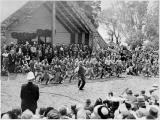About 1600 troops invaded the western Taranaki settlement of Parihaka, which had come to symbolise peaceful resistance to the confiscation of Māori land.
Parihaka Attack
Events In History
Under the leadership of Te Whiti-o-Rongomai and Tohu Kākahi, Parihaka Māori began a ploughing campaign in protest against European settlement on land confiscated from Māori.
Articles
Treaty timeline

See some of the key events between 1800 and 1849 relating to the Treaty of Waitangi. Read the full article
Page 2 - Treaty events 1850-99
See the key events between 1850 and 1899 relating to the Treaty of
Tītokowaru's war
In the 1980s James Belich argued that Tītokowaru’s war had become a ‘dark secret’ of New Zealand history, ‘forgotten by the Pākehā as a child forgets a nightmare’. For Belich, Tītokowaru was ‘arguably the best general New Zealand has ever produced’. Read the full article
Page 1 - Tītokowaru's war
In the 1980s James Belich argued that Tītokowaru’s war had become a ‘dark secret’ of New Zealand history, ‘forgotten by the Pākehā as a child forgets a nightmare’. For Belich,
Page 8 - A return to peace
In late 1869 Tītokowaru had his third conversion to peace, after which his relationship with Te Whiti-o-Rongomai and Tohu Kākahi of Parihaka
Te Tangata Kōhuru: The Murderous Man
The career of John Bryce, known to many students of 19th-century New Zealand history as the Native Minister who led the invasion of Parihaka, is an interesting example of how to approach historical perspective. In the eyes of many Māori he was Tangata Kōhuru – The Murderous Man, while in his own settler community he was referred to in much kinder terms as ‘Honest John’. Read the full article
Page 1 - Te Tangata Kohuru: The Murderous Man
The career of John Bryce, known to many students of 19th-century New Zealand history as the Native Minister who led the invasion of Parihaka, is an interesting example of how to











